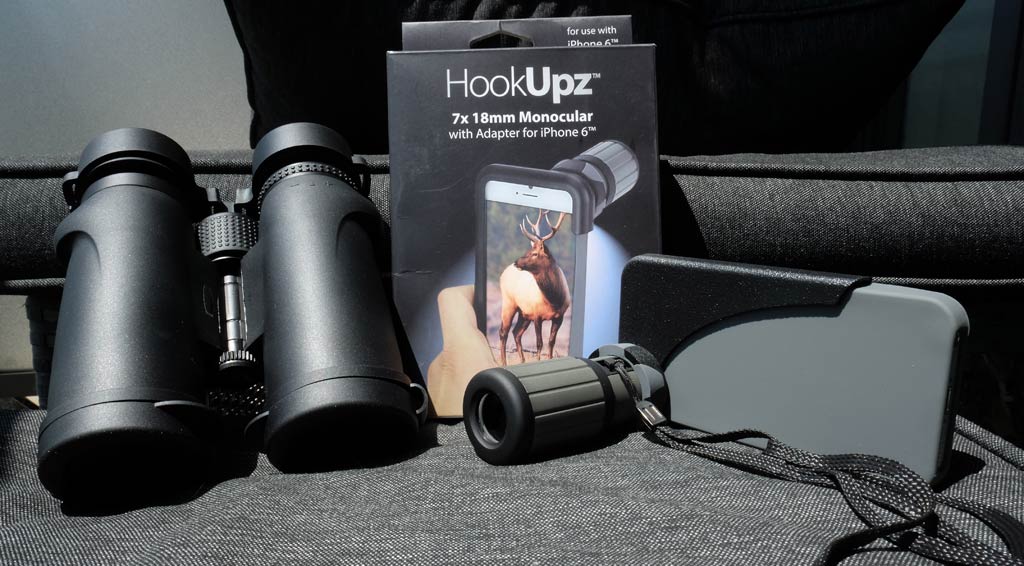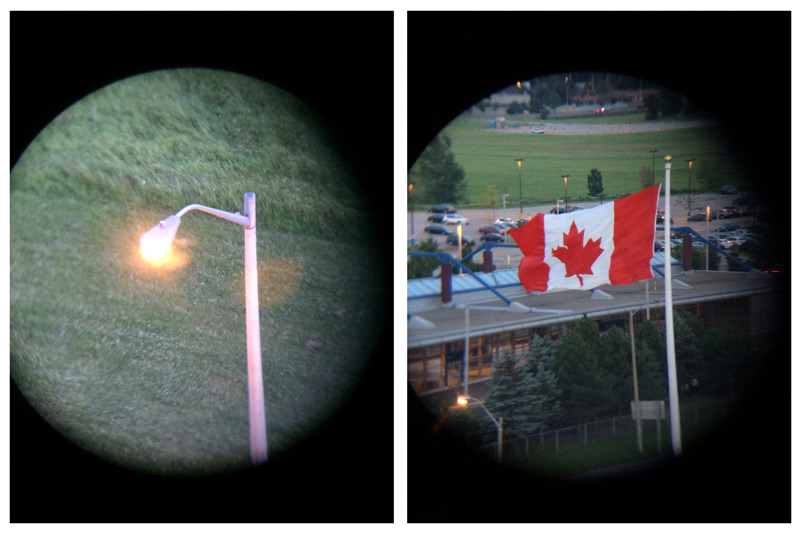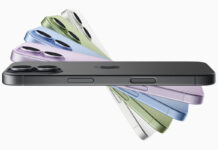
It might seem a little far-fetched when thinking of a smartphone attached to an object of considerable size, like a DSLR camera lens or even a pair of binoculars. Products like that are out there, amplifying the focal length of the phone’s camera, and thereby changing the very scope (pun intended) of images it can capture. Carson doesn’t have a DSLR lens, but it does make monoculars and binoculars with adapters for the iPhone and Samsung Galaxy devices.
In a previous review, I looked at Carson’s lenses for macro photography and microscopic images, whereas here, I was dealing with a monocular lens and a binocular adapter that works with Carson’s VP-042 42mm binoculars. Where the other lenses were about getting really close to a subject, the CloseUp Monocular and Binocular Adapter are about shooting faraway subjects from a distance.
CloseUp Monocular with HookUpz Adapter
 It’s no secret that smartphones have no optical zoom, and as such, aren’t able to really zoom in on subjects that are a distance away. Digital zoom can do it, but I always advise against it because it is software processing that ultimately degrades image quality. Those looking for something that can cut down the distance from the subject considerably may like what the CloseUp Monocular is about.
It’s no secret that smartphones have no optical zoom, and as such, aren’t able to really zoom in on subjects that are a distance away. Digital zoom can do it, but I always advise against it because it is software processing that ultimately degrades image quality. Those looking for something that can cut down the distance from the subject considerably may like what the CloseUp Monocular is about.
There isn’t much to the unit itself, requiring little setup. The Monocular is made up of three parts. There is a rubberized gel case that covers the phone’s back and sides, along with a hardened plastic casing that holds and aligns the adapter to the phone’s lens. The Monocular slides into the adapter, and that’s it. Much like the MicroMax Plus lens, the view from any photo app when using this is true to how a Monocular looks when viewed through one’s eye—all black around a circular image area.
The same usability principles apply, too. Focusing and zooming can be done manually by rotating the Monocular, though a camera app with auto-focus may also be able to assist in locking on to a subject. Balance is also important here because zooming in at a greater distance makes the camera more sensitive to any shaking from your hands. There isn’t a tripod mount associated with the Monocular or the HookUpz Adapter, unfortunately, but planting it on a flat surface and holding it in place that way is one way to mitigate the shakiness.
Photo quality really depends on a few factors, and while it’s great to shoot from a distance, the Monocular can’t mask the phone camera’s shortcomings. In other words, if the phone struggles to shoot crisp images at night or in low-light, the Monocular can’t do much to solve that issue, despite the fact it can improve overall results. The images above were taken after the sun had set, so it’s not a total wash if the lights dim. I got more comfortable shooting over time, though there is definite trial and error involved in getting the right shots and angles.
One design flaw I didn’t particularly care for was the recessed power button on the iPhone. The plastic casing that holds the adapter is high enough above the power button that I needed to hit it at a 90-degree angle with my fingernail or use an object thin enough to get in there.
An accessory like this is largely about experimentation, which is why the Monocular is easy to use by anyone, but not necessarily meant for everyone. Using it with any photo app can yield some interesting results, and those with a creative streak are probably going to come up with some funky ideas on how to use this.

Binocular Adapter
 To test this out, I had the Carson VP-042 binoculars with me. The adapter itself is virtually the same as the one for the Monocular, except that it has a larger diameter to fit the binocular’s larger eyepiece. At 42mm, they could go a considerable distance, giving me the chance to view scenery that was kilometres away.
To test this out, I had the Carson VP-042 binoculars with me. The adapter itself is virtually the same as the one for the Monocular, except that it has a larger diameter to fit the binocular’s larger eyepiece. At 42mm, they could go a considerable distance, giving me the chance to view scenery that was kilometres away.
This was a two-handed affair because there was no way the adapter could support the weight of the binoculars on its own, so one hand held the phone, while the other the binoculars. This can make adjusting focus and depth on the fly a little challenging, since there is no easy way to holding the phone in place when fiddling with the dial on the binoculars.
Like the Monocular, the view on the phone is of a circular image area surrounded by black. But, of course, the distance is considerably longer. I could see a car close enough to make out the license plate that was easily a few hundred feet away. A cityscape that was much further away was now a lot easier to see. The images above are standard, and even in dimmer settings, the images can keep up reasonably well.
I admit that I’m not one to use binoculars regularly, so it did come off as a novelty for me in the course of testing out the adapter. Like the Monocular, this is simple enough for anyone to use, but is probably not for everyone. For instance, if you’re not interested in the outdoors or viewing scenery from a distance, this is probably not for you. I like seeing nature myself, particularly animals, and with an adapter like this, it would be possible to take the kind of photos or video that simply couldn’t happen with the phone itself.
Final Thoughts
I found both of these products interesting to use, but want to reiterate that they are very much hobbyist accessories. Despite being simple enough to use by anyone in the mainstream, there has to be a genuine interest in what they can do. Smartphone cameras are increasingly sophisticated, but range is going to be an issue for the foreseeable future, and lens accessories are the best way to cut down the distance.
These serve that purpose, and for hobbyists, it’s a way to fuse a smartphone with optical products they’re already used to.
Both the CloseUp Monocular with HookUpz Adapter
and Binocular Adapter are available now for the iPhone 5/5s, iPhone 6 and Samsung Galaxy S4.
Also check out my earlier article for macro photography accessories for your smartphone, and an article by Steven Hill about going much smaller with the Carson digital microscope!




Thanks for this review Ted. I’ve been really curious about how well these perform, especially since they’re so inexpensive for the most part.
Comments are closed.